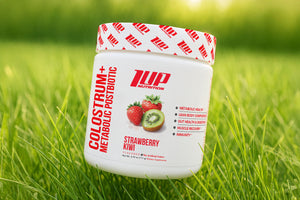All fitness journeys begin more or less the same way -- inspiration strikes, motivation is high, workout clothes are on point, and you’re at the gym crushing your workouts.
Results are coming almost effortlessly.
Then, after a few weeks of enjoying the benefits of “newbie gains,” progress starts to slow, and then in another week or two, progress comes to a grinding halt and you’re stuck.
What gives?
You’re still doing the same workouts and eating the same amount of calories, but what was once working great and all of a sudden stopped working.
Unfortunately, you’ve hit something every person who has ever stepped foot into a gym has experienced -- a plateau.
In this article, we’ll give you 5 different ways to shatter a plateau so that should you encounter one, you’ll be ready to topple it and continue on the path to long-term, sustainable results in muscle, strength, and body composition.
First, let’s start by answering a simple question...
What is a Plateau?
Geographically speaking, a plateau is a level (flat) region of high ground. And, this pretty much describes what a fitness plateau is -- your progress is basically flat.
A more technical definition would be “a state of little or no change following a period of activity or progress.”
Whichever way you spin it, when you are stuck on a plateau, your results are stagnant.
Now, “results” can mean any number of things depending on your performance and/or physique goals.
For some individuals, a plateau could mean that weight loss has come to a grinding halt, and the exercise and routine that was stripping away pounds has seemingly stopped working.
For others, a plateau could mean that gains in muscle size or strength, and no matter how many sets and reps you continue to grind out, you just can’t seem to progress no matter how hard you try.
Regardless of which type of plateau you’re facing, the end result is the same -- a mélange of frustration, despair, desperation, and a relentless yearning to understand how to right the ship that has veered off course.
For many, the worst part of hitting a plateau isn’t so much the fact that they hit a plateau, but not knowing what they need to do in order to fix the plateau -- should they eat more calories, should they eat fewer calories, should they train more, should they train less, should they use full-body workouts, or should they follow a split training routine?
Suffice it to say there isn’t a one-size-fits-all answer for every person in the world in every occasion.
But, up next, we’ll give you 5 different ways to crush a plateau so that you’re armed and ready the next time your progress stalls.
5 Ways to Crush a Plateau
Plan for Plateaus
There’s an old saying that states that “nothing works forever,” and nowhere is this truer than the world of fitness.
Yes, every diet or training program (within reason) will work for some finite amount of time, but after a while all programs and diets (even the most perfectly optimized ones) will stop working.
The reason for this is simple -- our bodies adapt.
You see, the human body is the most sophisticated machine ever created. It was engineered to adapt to whatever is thrown its way in order to survive.
What this means for your fitness and physique goals is that you will eventually need to tweak your diet and exercise routine in order to keep making progress.
While you won’t always know what tweaks you’ll need to make (that’s part of the experimentation process -- and fun! -- of creating your own exercise routines), by understanding that you’ll eventually need to change things up to keep making progress, you’ll avoid much of the frustration, disappointment, and dejected feelings that many people experience the first time they hit a plateau.
Recalculate Calorie Needs
Regardless if your goal is muscle gain or fat loss, you’ll eventually need to adjust the number of calories you’re eating in order to keep progressing.
The reason for this is due to something called metabolic adaptation.
Basically, as you gain or lose weight, your metabolism adjusts to the changes in your body weight and energy intake and adjusts your metabolism such that it has a new “equilibrium.”
For example, let’s say initially you were losing weight eating 2000 calories per day.
However, after a few weeks, you lose several pounds (all while still consuming 2000 calories per day continuously), and then eventually you stop losing weight.
Since you lost weight, your body has to move less mass, which means you’re burning fewer calories through movement, since you’re moving less weight. Plus, your metabolism downshifts to accommodate the decreased caloric needs of your lighter bodyweight.
In fact, studies show your resting energy expenditure decreases approximately 6.8 calories per pound of body weight lost.[1]
To compensate for your adjusted energy needs, you must recalculate the number of calories you need to eat each day as well as the specific amount of macros (protein, carbs, and fat) you need, too.
A general guideline to follow when dieting is to re-evaluate your caloric needs every few weeks as the weight continues to drop, and in all likelihood, you’ll have to reduce calories further to continue losing weight.
At the same time, remember to not drop calories too low, too fast as that could lead to another fat loss plateau.
If you’re not sure how many calories you should be eating, or need help figuring out how many calories you need to lose weight or gain muscle, click here.
Vary Rep Ranges
When initially embarking on a life of health and fitness, we’re all inundated by a certain set of paradigms.
Chief among these is how many repetitions you should perform each set based on your goals.
If your foray into fitness was anything like ours, you were likely told that if you wanted to:
- Gain strength -- lift in the 1-5 rep range
- Build muscle -- lift in the 8-12 rep range
- Build endurance -- lift in the 15+ rep range
And while this largely holds true, the reality is that you can build muscle across a wide variety of rep ranges, from very low rep ranges (3-5 reps per set) all the way up to very high rep ranges (20-30 reps per set).
Furthermore, when you start to hit the top end of a rep range (such as the 8-12 rep range), so long as you keep adding weight to the bar to keep your muscles failing in the prescribed rep range, you’ll gain strength too.
For example, beginners can follow the same workout (such as 5x5) for 3-6 months and continue to see progress simply because they’re new to training and their muscles will adapt to just about anything.
Intermediate and advanced gym rats’ muscles are more experienced, which means they require new stimuli more frequently in order to avoid plateaus and keep progressing.
One of the best ways to avoid plateaus is to switch up which rep ranges you train with every couple of mesocycles.
If you spend 3-4 weeks primarily training in the 8-12 rep range, spend a few weeks in the 5-8 rep range, and then another couple of weeks in the 15-20 rep range.
By rotating through these rep ranges every few weeks, you’ll make new gains in muscle and strength while simultaneously avoiding plateaus.
Plus, changing up your repetition scheme, can also help inject some new enthusiasm into a training routine that has become stale and spark motivation and enthusiasm to train harder.
Increase Training Frequency
Following up on the previous point, besides adjusting which rep ranges you train with, another way to help “shake up” your fitness routine is to increase your training frequency, or how many times per week you train a particular muscle group.
If you’re following a traditional body part split, you may only be training a muscle group once per week.
By increasing training frequency, you’ll split the number of sets that you typically perform in one day across two or three days. The benefit of splitting up your weekly training volume across more days is that you’ll be better able to dedicate a greater amount of effort to each set, meaning you’ll be able to move more weight for more reps due to spreading out the cumulative fatigue across several days.
This approach can be particularly useful for those looking to break through strength plateaus.
Reduce Training Intensity
Sometimes, the solution to your plateau isn’t to do more, it’s to do less.
So often, we’re led to believe that “more is better” -- more cardio, more HIIT, more calorie cutting.
However, as great as the old adage is “more is better” and as much as #teamnodaysoff sells on insta-face, the truth is that more is not always better.
Sometimes your body and mind just need a break.
Dieting for weeks on end can be incredibly taxing to both the body and mind (calorie restriction is a major stressor to the body after all).
And, there’s only so much stress the body can handle before it says “I’m done.”
If you’ve tried everything else (cutting calories, doing more reps, increasing frequency, etc.), and still can’t seem to break through your plateau, try easing off the intensity of your training or returning to maintenance calories for a week or two.
After the reprieve, restart your fat loss or muscle gain diet and training program, and you may be surprised to find out that your plateau has been shattered and you’re on your way to effortless gains once again!
The Bottom Line on How to Crush a Plateau
Plateaus are frustrating, and at times they can be de-motivating and demoralizing.
But, they don’t have to be that way, even though plateaus are (unfortunately) part of the process of getting fitter.
Use the tips in this article to help crush your plateaus, be it weight loss, muscle gain, or body recomposition, and be on your way to long-term gains, nary the stress and frustration.
References
- Schwartz A, Doucet E. Relative changes in resting energy expenditure during weight loss: a systematic review. Obes Rev. 2010;11(7):531-547. doi:10.1111/j.1467-789X.2009.00654.x.






